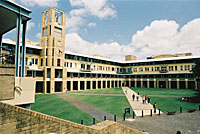|
 |
|
 |
| |
| |
| |
| |
| |
| |
| |
Campus: Kensington Campus
| |
| |
Career: Undergraduate
| |
| |
Units of Credit: 6
| |
| |
| |
| |
Indicative Contact Hours per Week: 3
| |
| |
Enrolment Requirements:
| |
| |
Prerequisite: MUSC1302 or MUSC1312 or MUSC2111 or MUSI1142
| |
| |
| |
| |
| |
 |
|
 |
Description
Introduces the musical traditions of India in their socio-cultural contexts. Students apply and refine their understanding of aspects of ethnomusicological theory, methods and issues.
Learning Outcomes
Upon completion of this course, students should be able to:
- Identify and discuss key components, including pitch and rhythmic systems, of South Asian classical music
- Identify, categorise and describe major instruments of South Asian classical music
- Identify and outline the structure of key genres of North Indian music
- Discuss the categorisation of musical fields and genres in South Asian, extrapolating from this to more general discussion of field and genre
- Understand key processes operating in the learning and performance of South Asian classical music
- Investigate the interactions between genre, field and society, both synchronically and diachronically
- Appreciate some of the aesthetic principles operating in South Asian music
- Come to an understanding of how elements discussed under objectives 1-7 are based in South Asian society, whilst understanding music as a 'text' of that society
- Investigate and critique the discipline of (ethno-)musicology in studying and representing the above.
Assessment
- Essay (2000 words) - 35%
- Ethnomusicology 'mock' field work exercise - 45%
- Tutorial presentation and comments/questions on other student presentations - 20%
|



